
Willem Drost was a Dutch Golden Age painter and printmaker of history paintings and portraits.

Carel Pietersz. Fabritius was a Dutch painter. He was a pupil of Rembrandt and worked in his studio in Amsterdam. Fabritius, who was a member of the Delft School, developed his own artistic style and experimented with perspective and lighting. Among his works are A View of Delft, The Goldfinch (1654), and The Sentry (1654).
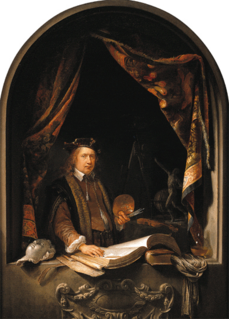
Gerrit Dou, also known as GerardDouw or Dow, was a Dutch Golden Age painter, whose small, highly polished paintings are typical of the Leiden fijnschilders. He specialised in genre scenes and is noted for his trompe-l'œil "niche" paintings and candlelit night-scenes with strong chiaroscuro. He was a student of Rembrandt.

Jan Lievens was a Dutch Golden Age painter who was associated with his close contemporary Rembrandt, a year older, in the early parts of their careers. They shared a birthplace in Leiden, training with Pieter Lastman in Amsterdam, where they shared a studio for about five years until 1631. Like Rembrandt he painted both portraits and history paintings, but unlike him Lievens' career took him away from Amsterdam to London, Antwerp, The Hague and Berlin.

Rembrandt Harmenszoon van Rijn was a Dutch draughtsman, painter, and printmaker. An innovative and prolific master in three media, he is generally considered one of the greatest visual artists in the history of art and the most important in Dutch art history. Unlike most Dutch masters of the 17th century, Rembrandt's works depict a wide range of style and subject matter, from portraits and self-portraits to landscapes, genre scenes, allegorical and historical scenes, and biblical and mythological themes as well as animal studies. His contributions to art came in a period of great wealth and cultural achievement that historians call the Dutch Golden Age, when Dutch art, although in many ways antithetical to the Baroque style that dominated Europe, was extremely prolific and innovative and gave rise to important new genres. Like many artists of the Dutch Golden Age, such as Jan Vermeer of Delft, Rembrandt was also an avid art collector and dealer.

The Indianapolis Museum of Art (IMA) is an encyclopedic art museum located at Newfields, a 152-acre (0.62 km2) campus that also houses Lilly House, The Virginia B. Fairbanks Art & Nature Park: 100 Acres, The Gardens at Newfields, the Beer Garden, and more. It is located at the corner of North Michigan Road and West 38th Street, about three miles north of downtown Indianapolis, northwest of Crown Hill Cemetery. There are exhibitions, classes, tours, and events, many of which change seasonally. The entire campus was previously referred to as the Indianapolis Museum of Art, but in 2017 the campus and organization were renamed "Newfields" to better reflect the breadth of offerings and venues. The "Indianapolis Museum of Art" now specifically refers to the main art museum building that acts as the cornerstone of the campus, as well as the legal name of the organization doing business as Newfields.

A tronie is the name given to a type of work common in Dutch Golden Age painting and Flemish Baroque painting that depict an exaggerated facial expression or people in costume. These works were not intended as portraits but as studies of expression, type, physiognomy or an interesting character such as an old man or women, a young woman, the soldier, the shepherdess, the Oriental, or a person of a particular race, etc.

Charles Sedelmeyer (1837–1925) was an Austrian art dealer, collector, and publisher active in Paris from 1866, with premises at 6 rue de la Rochefoucauld.
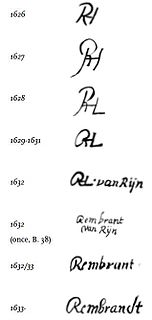
The Rembrandt Research Project (RRP) is an initiative of the Nederlandse Organisatie voor Wetenschappelijk Onderzoek (NWO), which is the Netherlands Organization for Scientific Research. Its purpose is to organize and categorize research on Rembrandt van Rijn, with the aim of discovering new facts about this Dutch Golden Age painter and his studio. The project was started in 1968, but has since become the authority on Rembrandt and has the final say in whether a painting is genuine.

Self Portrait is an oil on canvas painting by the Dutch artist Rembrandt. Painted in 1652, it is one of over 40 painted self-portraits by Rembrandt, and was the first he had painted since 1645. In composition it is different from his previous self-portraits, depicting the painter in a direct frontal pose, hands on his hips, and with an air of self-confidence. It was painted the year that his financial difficulties began, and breaks with the sumptuous finery he had worn in previous self-portraits. Art historian Christopher White has called it "one of the most magisterial and sombre of these (late) pictures". It is in the Kunsthistorisches Museum in Vienna.

Self-Portrait with Beret and Turned-Up Collar is a 1659 oil on canvas painting by the Dutch artist Rembrandt, one of over 40 self-portraits by Rembrandt. It has been noted as a self-portrayal of subtle and somber qualities, a work in which may be seen "the stresses and strains of a life compounded of creative triumphs and personal and financial reverses". Once owned by Andrew W. Mellon, it has been in the National Gallery of Art since 1937.
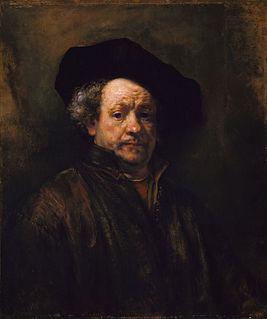
Self-Portrait is a 1660 oil on canvas painting by the Dutch artist Rembrandt, one of over 40 self-portraits by Rembrandt. Painted when the artist was fifty-four, it has been noted as a work in which may be seen "the wrinkled brow and the worried expression the troubled condition of his mind". Part of the Benjamin Altman Collection, it has been in the Metropolitan Museum of Art since 1913.
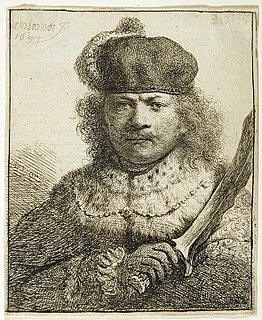
The dozens of self-portraits by Rembrandt were an important part of his oeuvre. Rembrandt created approaching one hundred self-portraits including over forty paintings, thirty-one etchings and about seven drawings; some remain uncertain as to the identity of either the subject or the artist, or the definition of a portrait.
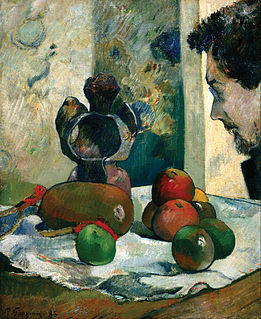
Still Life with Profile of Laval is an 1886 oil painting by French artist Paul Gauguin, located in the Indianapolis Museum of Art, which is in Indianapolis, Indiana. It depicts Gauguin's friend Charles Laval in profile with an assortment of inanimate objects, including a ceramic pot Gauguin made himself.
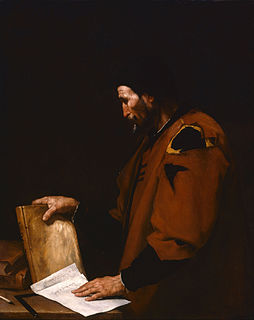
Aristotle is a 1637 oil painting by Spanish artist Jusepe de Ribera, located in the Indianapolis Museum of Art, which is in Indianapolis, Indiana. It is part of a series of six portraits of ancient philosophers commissioned by the Prince of Liechtenstein in 1636.
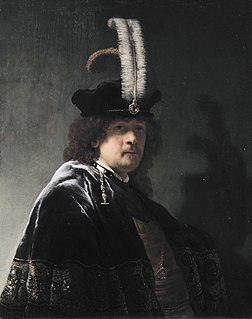
Self-portrait wearing a white feathered bonnet is an oil painting attributed to the Dutch painter Rembrandt. It is signed and dated 1635. It was traditionally regarded as a Rembrandt self-portrait until 1968, when it was rejected on stylistic grounds in the Rembrandt catalogue raisonné by Horst Gerson. On 18 March 2013 it was re-attributed to the master by Ernst van de Wetering. It is one of over 40 painted self-portraits by Rembrandt.

'Tronie' of a Young Man with Gorget and Beret, formerly known as Self-portrait as a young man is a tronie portrait of a young man that was traditionally regarded as one of over 40 painted self-portraits by Rembrandt. It is now in the Galleria degli Uffizi in Florence, where the most recent restoration by Daniele Rossi revealed a signature previously hidden under old varnish.

Young Woman in a Pearl Necklace is an oil on canvas painting by the Dutch painter Willem Drost. It is an example of Dutch Golden Age painting and is part of the collection of Gemäldegalerie Alte Meister.

Young Woman in a Pearl Necklace is an oil on canvas painting by an unknown painter, after a painting by the Dutch painter Willem Drost. It is an example of Dutch Golden Age painting and is part of the collection of the Metropolitan Museum of Art.

Rembrandt Laughing is a c. 1628 oil on copper painting by the Dutch painter Rembrandt van Rijn. It is elaborate study of a laughing face, a tronie, and, since it represents a painter himself, one of over 40 self-portraits by Rembrandt, probably the earliest elaborate one. The painting, which was only recently discovered is now in the J. Paul Getty Museum, California.



















